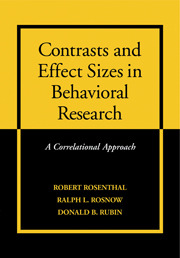5 - Contrasts in Repeated Measures
Published online by Cambridge University Press: 18 April 2011
Summary
The contrasts discussed in earlier chapters were from studies in which each subject contributed only a single score. In the present chapter, contrasts are from studies in which each subject contributes two or more scores. Such studies are often referred to as repeated measures studies because each subject is measured repeatedly. Two broad types of repeated measures studies can be distinguished: those that must be conducted as repeated measures studies and those that are conducted as repeated measures studies for reasons of design efficiency.
INTRINSICALLY REPEATED MEASURES STUDIES
In intrinsically repeated measures studies, the repeated measures are required in order to construct an outcome measure (or score) for each subject. For example, suppose we wanted to know whether individual females or individual males were more variable in the scores they earned on verbal, quantitative, and analytic subtests of the Graduate Record Examination. It would then be necessary to create an outcome measure that indexes the variability, for each subject, of the three scores earned on the three subtests. We might define variability for each subject by computing the range or the standard deviation of the three scores. This study would be a repeated measures study in the intrinsic sense because we could not have defined a sensible outcome measure indexing variability without obtaining repeated measures from each subject.
Information
- Type
- Chapter
- Information
- Contrasts and Effect Sizes in Behavioral ResearchA Correlational Approach, pp. 125 - 150Publisher: Cambridge University PressPrint publication year: 1999
Accessibility standard: Unknown
Why this information is here
This section outlines the accessibility features of this content - including support for screen readers, full keyboard navigation and high-contrast display options. This may not be relevant for you.Accessibility Information
- 1
- Cited by
